1.2.5 Labour market
The labour market is a FACTOR MARKET (ie it is a market for one of the four factors of production – land, labour, capital and enterprise). In the labour market, the price of labour is the wage rate. This is the price per unit of time to hire a single worker.
Demand for labour
The supply of labour comes from people in households and the demand for labour comes from businesses.
The demand for labour is known as a derived demand, which means the demand for labour is dependent on the demand for the final goods and services that they produce. If there is high demand for the final goods and services they produce businesses will demand more labour; for example, in times of an economic boom. When demand for final goods fall the demand for labour will fall.
Demand for labour also increases when workers become more productive; for example, because they have better skills. Firms can choose to use capital or labour so if capital becomes more expensive then firms will demand more labour.
The demand curve for labour shows how many workers are hired at a given wage rate. It is downward sloping for two reasons:
The higher the wage rate, the less workers the firm can afford to hire. Capital substitution will occur. The lower the wage rate the more workers the firm can afford to hire. This will happen in the long run only as capital is fixed in the short run.
The income effect. When wages are higher, firms employ less people as they have less income to spend on increasing the workforce.
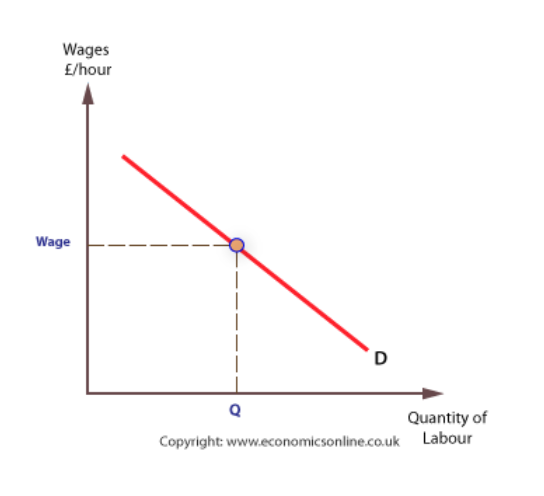
When there is a change in the wage rate, there is a movement along the demand curve. The higher the wage rate, the lower the demand for labour. Hence, the demand for labour curve slopes downwards.
Other factors will shift the labour demand curve:
The demand for the products
The demand for labour is a derived demand, which means it is ultimately based on demand for the product that labour makes. If consumers want more of a particular good or service, more firms will want the workers that make the product.
Productivity of labour
Productivity means output per worker, and If workers are more productive, they will be in greater demand. Productivity is influenced by skill levels, education and training, and the use of technology.
Substitutes
The extent to which labour is indispensable also affects the demand. If substitutes, such as capital machinery, become cheaper or more expensive, the demand curve for labour will shift to the left or right. For example, if the price of new technology falls there may be a reduction in demand for labour.
Supply of labour
The labour supply is defined as the number of workers willing and able to work, multiplied by the hours they are willing and able to work.
The supply of labour increases when the wage rate increases. The higher the wage rate, the more labour is supplied, which means the supply curve of labour will slope upwards. A worker's wage, along with any bonus, provides the main monetary benefit from working. When there is a change in the wage rate there is a movement along the supply curve.
Other factors will shift the supply of labour curve:
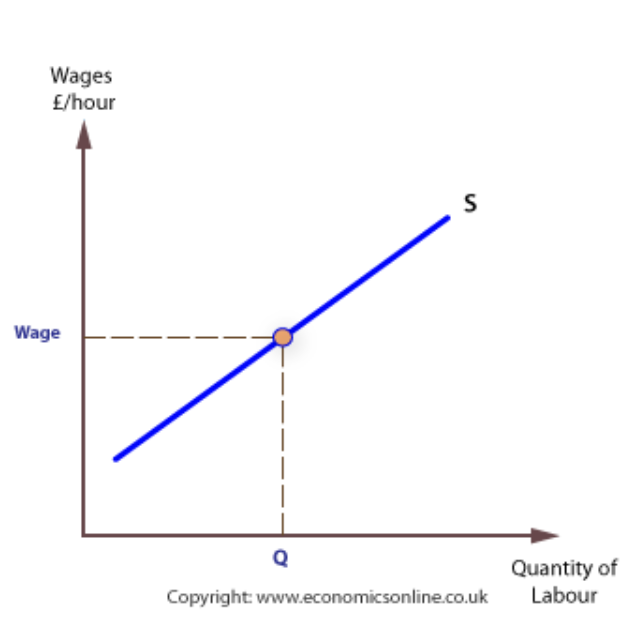
The size of the working population
The working population is the number of people of working age who are willing and able to work. The size of the working population is influenced by the retirement and school leaving ages, migration, and numbers staying on at University.
Migration
Migration can have a considerable impact on the labour market. Migrants tend to be of working age, and while the general effect is to increase the supply of labour at all wage rates, migration especially affects supply at lower wage rates. This is because migrants tend to come from low wage economies, with average wages often far below the minimum wage in the UK.
Age distribution of population
Supply of labour falls if there are a large number of old or young people in the population. Most developed countries have an aging population. This means that the number of people over the age of about 65 years as a proportion of the total population is increasing.
Retirement age
Retirement occurs when you reach a certain age and stop working and are eligible for government payouts (pension). In many developed countries, as people are living longer, the population is increasing.
School leaving age
Changes in the school leaving age have an impact on the supply of labour. If a country increases the school leaving age, this means children have to stay in education for longer and therefore the supply of labour falls.
Female participation
In the last 50 years, in many countries there has been a change in the role of women. An increasing number of women have entered the labour force, increasing the supply of labour.
Skills and qualifications.
If a job requires certain skills and qualifications, this can reduce the labour supply for a given occupation as it represents a barrier to entry. E.g. a doctor needs to train for 9 years. Therefore there tends to be lower supply of doctors compared to relatively unskilled professions, such as cleaners
Labour mobility
Immobility of labour is a cause of unemployment and market failure.
Occupational Immobility
People often experience occupational immobility. For example, workers made redundant in the steel industry or in heavy engineering may find it difficult to find a new job. They may have specific skills that are not necessarily needed in growing industries which causes a mismatch between the skills on offer from the unemployed and those required by employers looking for workers. This problem is called structural unemployment. Clearly this leads to a waste of scarce resources and represents market failure.
Geographical Immobility
Geographical immobility refers to barriers people moving from one area to another to find work. There are good reasons why geographical immobility might exist:
Family and social ties
The financial costs involved in moving home including the costs of selling a house and removal expenses.
Huge regional variations in house prices leading to a shortage of affordable housing in many areas
The high cost of renting property
Differences in the general cost of living between regions and also between countries
Migration controls e.g. a cap on inward migration
Cultural and language barriers
Overall if there is immobility in a market, supply of labour falls.
The importance of quantity and quality of labour to business
Firms ideally wish to employ cheap labour as this reduces costs and therefore makes them more competitive.
However, the business also needs to consider the quality of the labour force. Cheap labour generally means low skilled labour. If a firm decides to employ cheap labour, there may be additional costs such as training and education needed to upskill the employees.
When choosing a location to produce or to have business operations in, the firm needs to consider the quantity of available workers and the quality (whether or not the workers have the necessary skill to work at the desired standard).
The impact of education and training on human capital and quality of labour
Human capital means the skills and experience workers have.
Generally, employers will want to recruit people who can read and write and have good communication skills. They will also want to recruit people with specialist skills. If the labour supply is well educated and trained, it will be more productive. Over time, a country will want to improve the quality of labour so that it is more productive. This will require investment by the government and firms in training and education. The main reason for training is to provide workers with the skills and knowledge needed to do their jobs effectively. As a result, their productivity will increase.
However, there are several other reasons. For example, workers will need training if there are changes that might affect their jobs. Some examples might include new health and safety procedures, new technology or new working practices. Some businesses train their workers in a range of different jobs so that they are multi-skilled. This provides businesses with added flexibility.
Labour market diagrams
Wage determination – this is equilibrium (when D for labour = supply of labour)
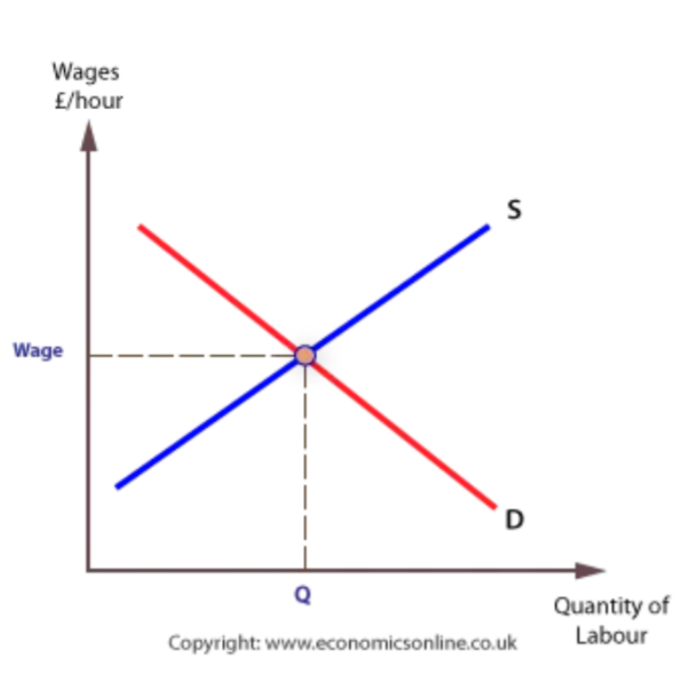
Any shifts in demand or supply of labour will change the equilibrium
Shifts
An increase in immigration, increases supply, shifting it to the right from SL1 to SL2. This causes the quantity of labour (number of workers employed) to increase from 60 000 and 80 000 and the wage rate to fall from $11 to $10. See diagram below (using the example of cleaners)
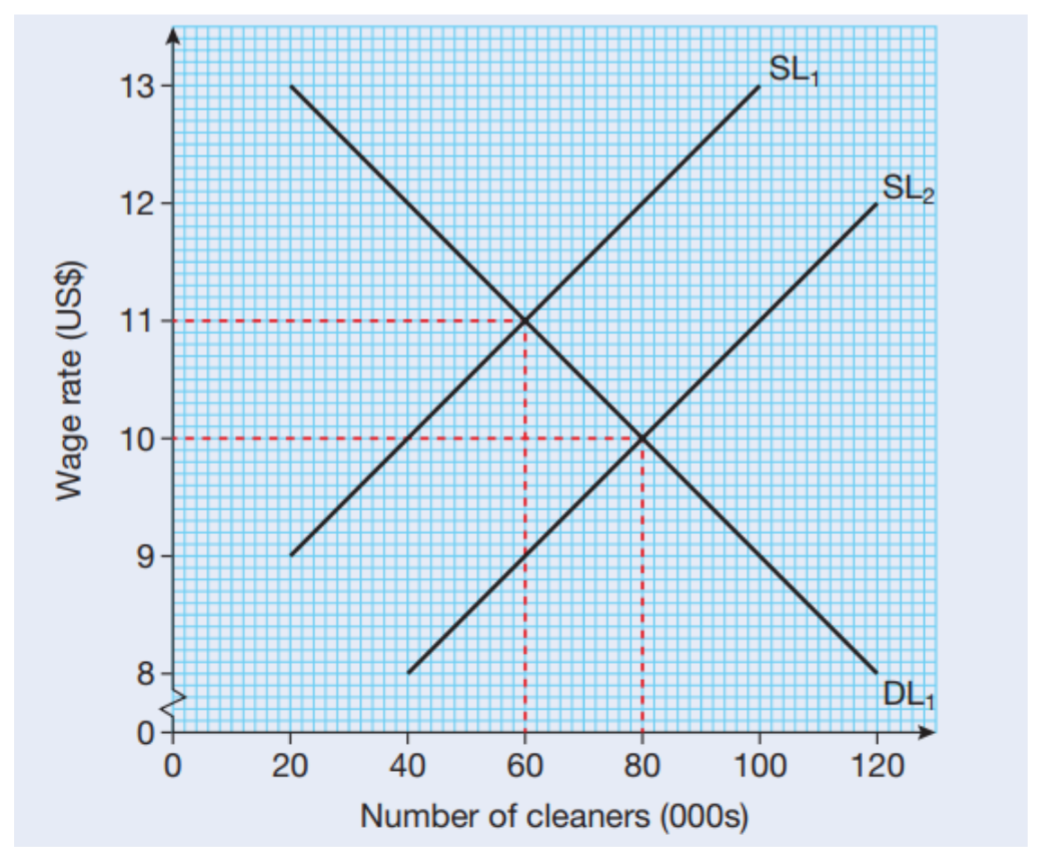
An increase in demand for the final produce will increase the demand for labour (labour is a derived demand). This causes demand for labour to increase and shift right from DL1 o DL2, causing an increase in employment from QL1 to QL2 and an increase in the wage rate from W1 to W2.
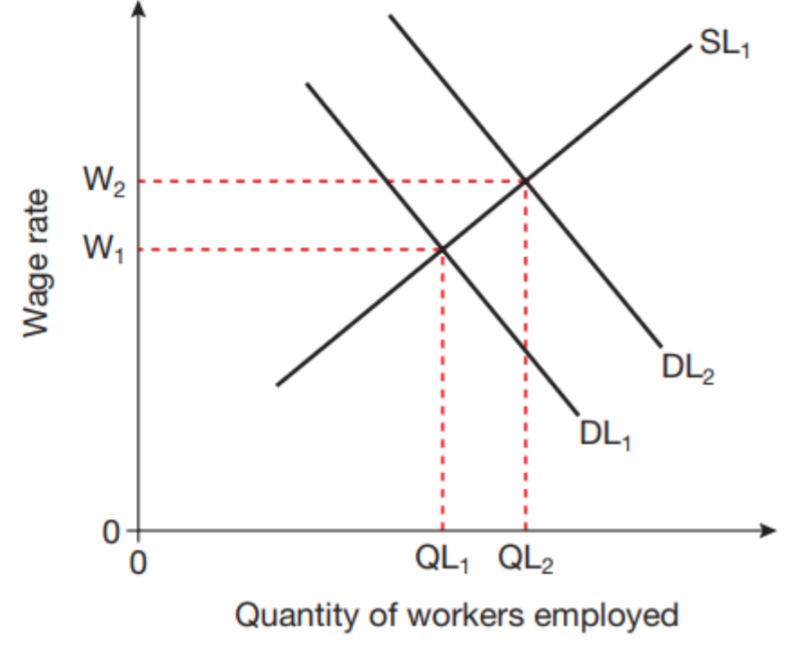
Trade union involvement in the labour market
Trade unions are organisations that exist to protect the interests of workers. The main aims of trade unions are to:
negotiate pay and working conditions with employers
provide legal protection for members, such as representation in court if an employee is fighting a case against an employer (discrimination in the workplace, for example)
put pressure on the government to pass legislation that improves the rights of workers
A strong trade union may be able to force wages up in some labour markets. If a union has the full support of its members, it can put pressure on employers during wage negotiations. When this happens, unions are able to affect wages and employment levels
Trade unions can encourage strike action (industrial action) if the employer does not agree to making certain changes (e.g. if they do no agree with pay increases). This means workers do not work for a given period of time (withdrawal of labour). Strike action is usually the last resort. Instead trade unions may encourage workers to “go slow” (work slowly) or “work to rule” (only do the jobs that are specified in the employment contract.
Some governments have reduced trade union power. E.g. in the UK, workers can be fired if they go on strike for too long.
Some economists also believe that if trade unions successfully push up wages, this can result in unemployment. This is because costs rise for firms, so firms may lay-off workers.
 Knowt
Knowt
